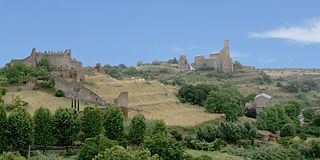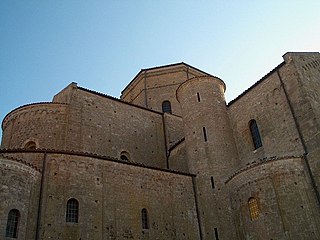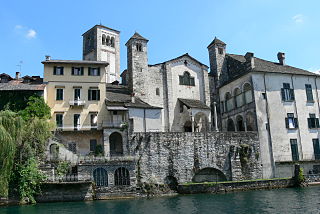
Romanesque architecture is an architectural style of medieval Europe that was predominant in the 11th and 12th centuries. The style eventually developed into the Gothic style with the shape of the arches providing a simple distinction: the Romanesque is characterized by semicircular arches, while the Gothic is marked by the pointed arches. The Romanesque emerged nearly simultaneously in multiple countries ; its examples can be found across the continent, making it the first pan-European architectural style since Imperial Roman architecture. Similarly to Gothic, the name of the style was transferred onto the contemporary Romanesque art.
The Church of the Holy Sepulchre is a church in the Christian Quarter of the Old City of Jerusalem, believed to be the site of Jesus Christ's empty tomb.

Tuscania is a town and comune in the province of Viterbo, Lazio Region, Italy. Until the late 19th century the town was known as Toscanella.

Acquapendente is a city and comune in the province of Viterbo, in Lazio (Italy). Acquapendente is a centre for the agricultural production of vegetables and wine, and has a tradition of pottery craftsmanship. Its frazione of Torre Alfina is one of I Borghi più belli d'Italia.

Sansepolcro, formerly Borgo Santo Sepolcro, is a town and comune founded in the 11th century, located in the Italian Province of Arezzo in the eastern part of the region of Tuscany.

San Pietro in Ciel d'Oro is a Catholic basilica of the Augustinians in Pavia, Italy, in the Lombardy region. Its name refers to the mosaics of gold leaf behind glass tesserae that decorate the ceiling of the apse. The plain exterior is of brick, with sandstone quoins and window framing. The paving of the church floor is now lower than the modern street level of Piazza San Pietro in Ciel d'Oro, which lies before its façade.

The Basilica of Sant'Ambrogio is an ancient Romanesque-style, Roman Catholic church in the center of Milan, region of Lombardy, Italy.

Fiesole Cathedral, officially the Cathedral of Saint Romulus of Fiesole, is a Roman Catholic cathedral in Fiesole, Tuscany, central Italy. It is the seat of the Bishop of Fiesole and is dedicated to Saint Romulus.

Acerenza Cathedral is a Roman Catholic cathedral dedicated to the Assumption of the Blessed Virgin Mary and to Saint Canius in the town of Acerenza, in the province of Potenza and the region of Basilicata, Italy. It is the seat of the Archbishop of Acerenza. It was declared a minor basilica in 1956.

The Italian Roman Catholic diocese of Acquapendente was an ecclesiastical territory in Lazio. The seat of the bishop was in the cathedral of Acquapendente, dedicated to the Holy Sepulchre. The diocese was established in 1649, when it was created in the place of the suppressed diocese of Castro. In 1986, along with other dioceses, it was merged into the diocese of Viterbo, Acquapendente, Bagnoregio, Montefiascone, Tuscania e San Martino al Monte Cimino.

Montefiascone Cathedral or the Basilica of Santa Margherita is a former Roman Catholic cathedral in Montefiascone in the province of Viterbo, Italy, dedicated to Saint Margaret of Antioch, the patron saint of the town. It was formerly the episcopal seat of the Diocese of Montefiascone and is now a basilica minor.

The Cathedral of Sansepolcro is a Catholic church in Sansepolcro, Tuscany, central Italy.

The Abbey of Santissima Trinità or Abbey of the Most Holy Trinity, Italian: Abbazia della Santissima Trinità, is a Roman Catholic abbey complex at Venosa, in the Vulture area of the province of Potenza, in the southern Italian region of Basilicata. The architecture of the abbey shows Roman, Lombard, and Norman influences. The complex lies within the Parco Archeologico of Venosa, approximately 1.5 km north-east of the town; it falls under the Roman Catholic Diocese of Melfi-Rapolla-Venosa. It consists of the old church, of uncertain date; the monastery buildings; and the Incompiuta, the unfinished or new church, begun in the last quarter of the eleventh century and never completed. The complex was declared a National Monument by Royal Decree on 20 November 1897. It is no longer a monastery, but is used by the Trinitarian Order.

Gualdo Tadino Cathedral is a Roman Catholic cathedral in Gualdo Tadino in Umbria, Italy, dedicated to Saint Benedict of Nursia. Formerly a Benedictine abbey church, it became a cathedral in 1915, and is now a co-cathedral in the diocese of Assisi-Nocera Umbra-Gualdo Tadino.

The Basilica di San Giulio is a Roman Catholic church on the small Isola San Giulio in the center of Lake Orta, province of Novara, north-western Italy. It has the status of a minor basilica. Although the island is part of the Orta San Giulio municipality, the basilica belongs to the San Giacomo parish, including the island and a portion of the west coast of the lake in San Maurizio d'Opaglio municipality.

Nepi Cathedral is a Neoclassical Roman Catholic cathedral located in Nepi, region of Lazio, Italy. It is dedicated to the Assumption of the Virgin Mary and to Saint Anastasia. It was the episcopal seat of the Diocese of Nepi, later Nepi and Sutri, suppressed in 1986, and is now a co-cathedral in the Diocese of Civita Castellana.

Montalto Cathedral, otherwise the Basilica of Santa Maria Assunta e San Vito, is the principal Roman Catholic church of the town of Montalto delle Marche, province of Ascoli Piceno in the region of Le Marche, Italy. It is dedicated to the Assumption of the Virgin Mary. The church was formerly, from 1586, the episcopal seat of the Diocese of Montalto. When the diocese was subsumed into the present Diocese of San Benedetto del Tronto–Ripatransone–Montalto in 1986, Montalto Cathedral became a co-cathedral in the new diocese. It was created a basilica minor by Pope Paul VI in 1965.

Sant'Andrea Apostolo is a Romanesque-style, Roman Catholic church located on the Piazza of the same name in the sector of Pianoscarano of Viterbo, region of Lazio, Italy.



















